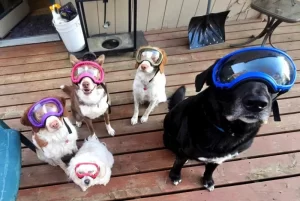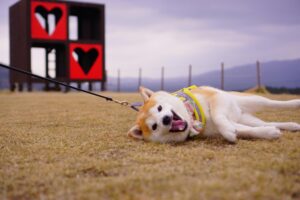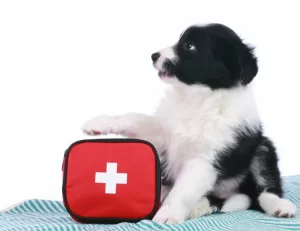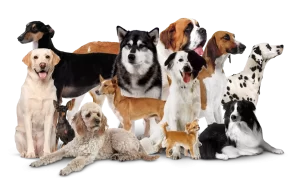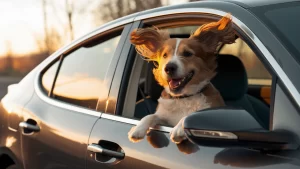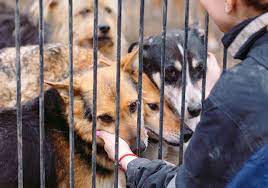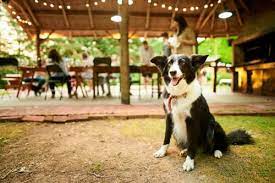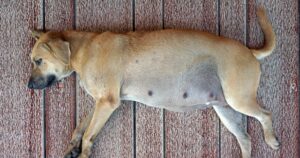As the threat of a volcanic eruption looms near Anchorage, residents are swiftly adapting to safeguard their furry companions. Recent warnings about Mount Spurr’s potential activity have urged pet owners to think ahead. This isn’t just about ashfall; it’s about ensuring that our pets are protected from the harmful effects of volcanic debris.
Dog owners like Alliana Salanguit and Jesslin Wooliver are leading the way, making clever purchases, including doggles and booties, to shield their pets from corrosive ash. The city’s advice has emphasized keeping pets indoors as much as possible while preparing for limited outdoor excursions, where protective gear is crucial. With local pet stores experiencing a surge in sales of items like canine respirators and goggles, these protective accessories aren’t just a cute add-on anymore; they’re becoming essential for pet safety.
In this blog post, we’ll explore how Anchorage residents are equipping their pets with the right gear to weather potential volcanic ashfall. We’ll provide insights into the types of protective equipment you should consider, along with tips on training your pets to adapt to their new gear. Stay informed and ensure your dogs are ready for whatever nature brings. For more information about popular dog breeds suitable for families, check out this guide on dog breeds safe with kids.
Table of Contents
ToggleUnderstanding the Volcanic Threat to Pets in Anchorage
As the potential for a volcanic eruption near Anchorage increases, pet owners must be proactive in safeguarding their furry friends. The danger posed by volcanic ash is significant, requiring thoughtful preparation and awareness of its composition and associated risks. This section will break down the characteristics of volcanic ash and provide insights from local authorities regarding pet safety during eruptions.
Volcanic Ash: Composition and Risks
Volcanic ash is made up of tiny, jagged particles that can spread across vast distances during an eruption. This material is not only unsightly but also poses several threats to pets, particularly dogs. Here’s how:
- Respiratory Issues: When inhaled, volcanic ash can irritate the lungs of both humans and pets. Dogs are particularly sensitive, and exposure can lead to conditions such as coughing, wheezing, or more serious respiratory complications.
- Eye Damage: Fine particles can easily enter a dog’s eyes, causing irritation or even long-term damage. The abrasiveness of ash poses a serious concern, especially for breeds with exposed eyes or allergies.
- Skin and Paw Health: Ash can cause skin irritations, lesions, or infections if it comes into prolonged contact with a dog’s skin. Moreover, the sharpness of the particles can harm the pads of a dog’s paws, making protective gear like booties essential.
- Ingestion Risks: If a dog ingests ash, whether through grooming or curiosity, it can lead to serious health issues, including poisoning or gastrointestinal distress.
Understanding these risks is crucial for pet owners in Anchorage as it enables them to take the necessary precautions. For more detailed information about protecting pets from volcanic ash, check out the guide from Alaska’s Department of Environmental Conservation.
Insights from Animal Control Experts
Local authorities in Anchorage are actively sharing advice on how pet owners can keep their animals safe during potential volcanic eruptions. Experts recommend several strategies to enhance pet safety:
- Keep Pets Indoors: Minimizing outdoor time is a fundamental step. It limits exposure to ash, reducing respiratory and skin risks.
- Use Protective Gear: Dogs should wear booties to protect their paws from sharp ash particles. Additionally, protective goggles help shield their eyes from irritants. Canine respirators are encouraged, especially for long walks.
- Vet Visits: Regular check-ups during such environmental stressors are vital for monitoring pets’ health and getting timely vaccinations or medications if necessary.
- Emergency Supplies: Keeping a kit with necessary supplies, including food, water, and any medications, ensures pets are cared for even during unforeseen circumstances.
Joel Jorgensen, a spokesman for Anchorage’s animal control agency, emphasized the importance of preparedness. He pointed out that if pet owners can acquire canine respirators, that would be a fantastic option to ensure respiratory safety. For a local perspective on expert recommendations, refer to the recent guidance on protecting pets from volcanic ash.
By understanding the composition and risks of volcanic ash, along with expert insights, Anchorage pet owners can make informed decisions to protect their beloved animals during this unpredictable time.
The Essential Gear: Doggles and Booties
As Anchorage residents prepare for the potential eruption of Mount Spurr, it’s essential to consider protective gear for our pets. Items like Doggles and booties serve not only functional purposes but also add a layer of comfort and safety. Here’s a closer look at why these gears are crucial for your furry companions.
Doggles: Protection with Style
Doggles, or dog goggles, are much more than just fashionable eyewear. Designed specifically for canines, these goggles protect dogs’ eyes from harmful environmental factors, including volcanic ash. Here are some key features that make Doggles a necessary addition:
- UV Protection: Many models come with UV-blocking lenses that shield your dog’s eyes from sun damage. While the immediate concern may be ash, it’s crucial to guard against future sunny days.
- Impact-Resistant Lenses: Made from durable materials, the lenses are impact-resistant, protecting dogs’ eyes not just from ash but also debris and other potential hazards.
- Comfortable Fit: Doggles often come with adjustable straps, ensuring they fit snugly without causing discomfort. A secure fit is vital for keeping the goggles on, especially if your dog is active.
By choosing Doggles, you’re providing your dog with stylish eye protection that doesn’t compromise on safety. For a look at various options available online, check out this great selection from Ruffwear.

Photo by Alexa Bonilla
Dog Booties: A Necessity for Paw Protection
Dog booties are not just a trend; they are essential for protecting your dog’s paws during volcanic ashfall. The sharp, abrasive nature of ash can lead to injuries that can severely affect your dog’s mobility. Here’s how dog booties can help:
- Injury Prevention: Booties shield dogs’ paws from cuts and abrasions caused by sharp particles in the ash. This protection is crucial for active dogs who might want to explore outside.
- Temperature Regulation: In colder conditions, booties help keep your dog’s paws warm while also protecting them from hot surfaces in the summer.
- Comfort on Uneven Terrain: Ash can create unstable ground. Booties provide extra grip and support, making it easier for your dog to walk safely.
Buying quality dog booties is a small price to pay for the peace of mind that comes with knowing your furry friend is safe. Check out options from Amazon or specialized pet stores for reliable choices.
Training Your Pet for Protective Gear
Acclimating your dog to wearing Doggles and booties can take time, but with patience and positive reinforcement, it can be an enjoyable experience. Here are some tips to help your pet adapt:
- Introduce Gradually: Start by letting your dog sniff and explore the gear at home. This helps reduce anxiety surrounding unfamiliar objects.
- Positive Association: Pair the introduction of the gear with something positive, like treats or playtime. This connection helps your dog view the gear as a good thing.
- Short Sessions: Begin with short wearing sessions. Gradually increase the time as your dog becomes more comfortable.
- Practice Outdoors: Once your dog is used to the gear indoors, take small outdoor excursions. Monitor their behavior to ensure they are comfortable.
Building a routine that includes wearing Doggles and booties may require some persistence, but it will ultimately be worthwhile. For expert guidance on pet training, visit NPR’s insights on preparing pets for volcanic eruptions.
By equipping your dog with the right protective gear and taking the time to train them, you can help ensure their safety in the face of potential volcanic activity.
Doggles and Booties: How Anchorage Residents Are Preparing Pets for Volcanic Eruptions
As the threat of a volcanic eruption looms near Anchorage, residents are swiftly adapting to safeguard their furry companions. Recent warnings about Mount Spurr’s potential activity have spurred an urgent need for pet owners to think ahead. This isn’t just about ashfall; it’s about ensuring that our pets are protected from the harmful effects of volcanic debris.
Dog owners like Alliana Salanguit and Jesslin Wooliver are leading the way, making clever purchases, including doggles and booties, to shield their pets from corrosive ash. The city’s advice has emphasized keeping pets indoors as much as possible while preparing for limited outdoor excursions, where protective gear is crucial. With local pet stores experiencing a surge in sales of items like canine respirators and goggles, these protective accessories aren’t just a cute add-on anymore; they’re becoming essential for pet safety.
In this blog post, we’ll explore how Anchorage residents are equipping their pets with the right gear to weather potential volcanic ashfall. We’ll provide insights into the types of protective equipment you should consider, along with tips on training your pets to adapt to their new gear. Stay informed and ensure your dogs are ready for whatever nature brings. For more information about popular dog breeds suitable for families, check out this guide on dog breeds safe with kids.
Understanding the Volcanic Threat to Pets in Anchorage
As the potential for a volcanic eruption near Anchorage increases, pet owners must be proactive in safeguarding their furry friends. The danger posed by volcanic ash is significant, requiring thoughtful preparation and awareness of its composition and associated risks. This section will break down the characteristics of volcanic ash and provide insights from local authorities regarding pet safety during eruptions.
Volcanic Ash: Composition and Risks
Volcanic ash is made up of tiny, jagged particles that can spread across vast distances during an eruption. This material is not only unsightly but also poses several threats to pets, particularly dogs. Here’s how:
- Respiratory Issues: When inhaled, volcanic ash can irritate the lungs of both humans and pets. Dogs are particularly sensitive, and exposure can lead to conditions such as coughing, wheezing, or more serious respiratory complications.
- Eye Damage: Fine particles can easily enter a dog’s eyes, causing irritation or even long-term damage. The abrasiveness of ash poses a serious concern, especially for breeds with exposed eyes or allergies.
- Skin and Paw Health: Ash can cause skin irritations, lesions, or infections if it comes into prolonged contact with a dog’s skin. Moreover, the sharpness of the particles can harm the pads of a dog’s paws, making protective gear like booties essential.
- Ingestion Risks: If a dog ingests ash, whether through grooming or curiosity, it can lead to serious health issues, including poisoning or gastrointestinal distress.
Understanding these risks is crucial for pet owners in Anchorage as it enables them to take the necessary precautions. For more detailed information about protecting pets from volcanic ash, check out the guide from Alaska’s Department of Environmental Conservation.
Insights from Animal Control Experts
Local authorities in Anchorage are actively sharing advice on how pet owners can keep their animals safe during potential volcanic eruptions. Experts recommend several strategies to enhance pet safety:
- Keep Pets Indoors: Minimizing outdoor time is a fundamental step. It limits exposure to ash, reducing respiratory and skin risks.
- Use Protective Gear: Dogs should wear booties to protect their paws from sharp ash particles. Additionally, protective goggles help shield their eyes from irritants. Canine respirators are encouraged, especially for long walks.
- Vet Visits: Regular check-ups during such environmental stressors are vital for monitoring pets’ health and getting timely vaccinations or medications if necessary.
- Emergency Supplies: Keeping a kit with necessary supplies, including food, water, and any medications, ensures pets are cared for even during unforeseen circumstances.
Joel Jorgensen, a spokesman for Anchorage’s animal control agency, emphasized the importance of preparedness. He pointed out that if pet owners can acquire canine respirators, that would be a fantastic option to ensure respiratory safety. For a local perspective on expert recommendations, refer to the recent guidance on protecting pets from volcanic ash.
By understanding the composition and risks of volcanic ash, along with expert insights, Anchorage pet owners can make informed decisions to protect their beloved animals during this unpredictable time.
The Essential Gear: Doggles and Booties
As Anchorage residents prepare for the potential eruption of Mount Spurr, it’s essential to consider protective gear for our pets. Items like Doggles and booties serve not only functional purposes but also add a layer of comfort and safety. Here’s a closer look at why these gears are crucial for your furry companions.
Doggles: Protection with Style
Doggles, or dog goggles, are much more than just fashionable eyewear. Designed specifically for canines, these goggles protect dogs’ eyes from harmful environmental factors, including volcanic ash. Here are some key features that make Doggles a necessary addition:
- UV Protection: Many models come with UV-blocking lenses that shield your dog’s eyes from sun damage. While the immediate concern may be ash, it’s crucial to guard against future sunny days.
- Impact-Resistant Lenses: Made from durable materials, the lenses are impact-resistant, protecting dogs’ eyes not just from ash but also debris and other potential hazards.
- Comfortable Fit: Doggles often come with adjustable straps, ensuring they fit snugly without causing discomfort. A secure fit is vital for keeping the goggles on, especially if your dog is active.
By choosing Doggles, you’re providing your dog with stylish eye protection that doesn’t compromise on safety. For a look at various options available online, check out this great selection from Ruffwear.

Photo by Alexa Bonilla
Dog Booties: A Necessity for Paw Protection
Dog booties are not just a trend; they are essential for protecting your dog’s paws during volcanic ashfall. The sharp, abrasive nature of ash can lead to injuries that can severely affect your dog’s mobility. Here’s how dog booties can help:
- Injury Prevention: Booties shield dogs’ paws from cuts and abrasions caused by sharp particles in the ash. This protection is crucial for active dogs who might want to explore outside.
- Temperature Regulation: In colder conditions, booties help keep your dog’s paws warm while also protecting them from hot surfaces in the summer.
- Comfort on Uneven Terrain: Ash can create unstable ground. Booties provide extra grip and support, making it easier for your dog to walk safely.
Buying quality dog booties is a small price to pay for the peace of mind that comes with knowing your furry friend is safe. Check out options from Amazon or specialized pet stores for reliable choices.
Training Your Pet for Protective Gear
Acclimating your dog to wearing Doggles and booties can take time, but with patience and positive reinforcement, it can be an enjoyable experience. Here are some tips to help your pet adapt:
- Introduce Gradually: Start by letting your dog sniff and explore the gear at home. This helps reduce anxiety surrounding unfamiliar objects.
- Positive Association: Pair the introduction of the gear with something positive, like treats or playtime. This connection helps your dog view the gear as a good thing.
- Short Sessions: Begin with short wearing sessions. Gradually increase the time as your dog becomes more comfortable.
- Practice Outdoors: Once your dog is used to the gear indoors, take small outdoor excursions. Monitor their behavior to ensure they are comfortable.
Building a routine that includes wearing Doggles and booties may require some persistence, but it will ultimately be worthwhile. For expert guidance on pet training, visit NPR’s insights on preparing pets for volcanic eruptions.
By equipping your dog with the right protective gear and taking the time to train them, you can help ensure their safety in the face of potential volcanic activity.

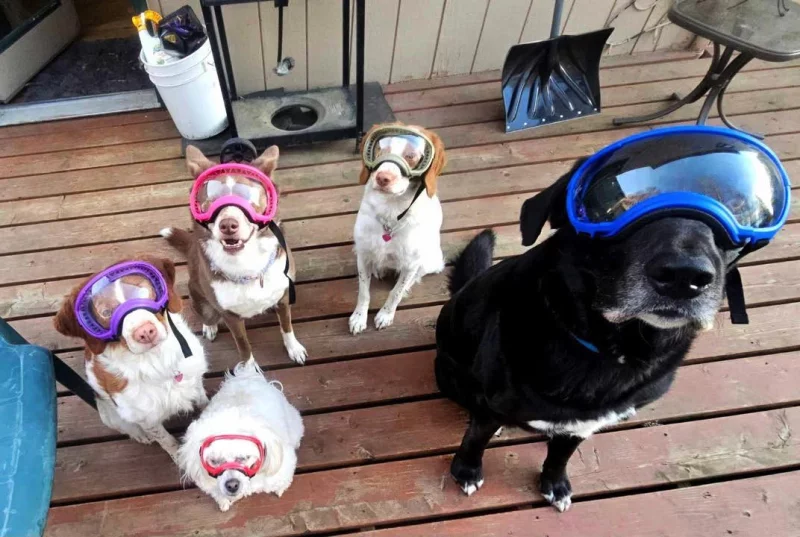



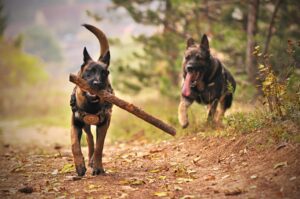



![The Ultimate Guide to Road Tripping with Your Dog [2025 Update]](https://bellabeanupdate.com/wp-content/uploads/2025/05/pexels-photo-1143369-300x209.jpeg)

